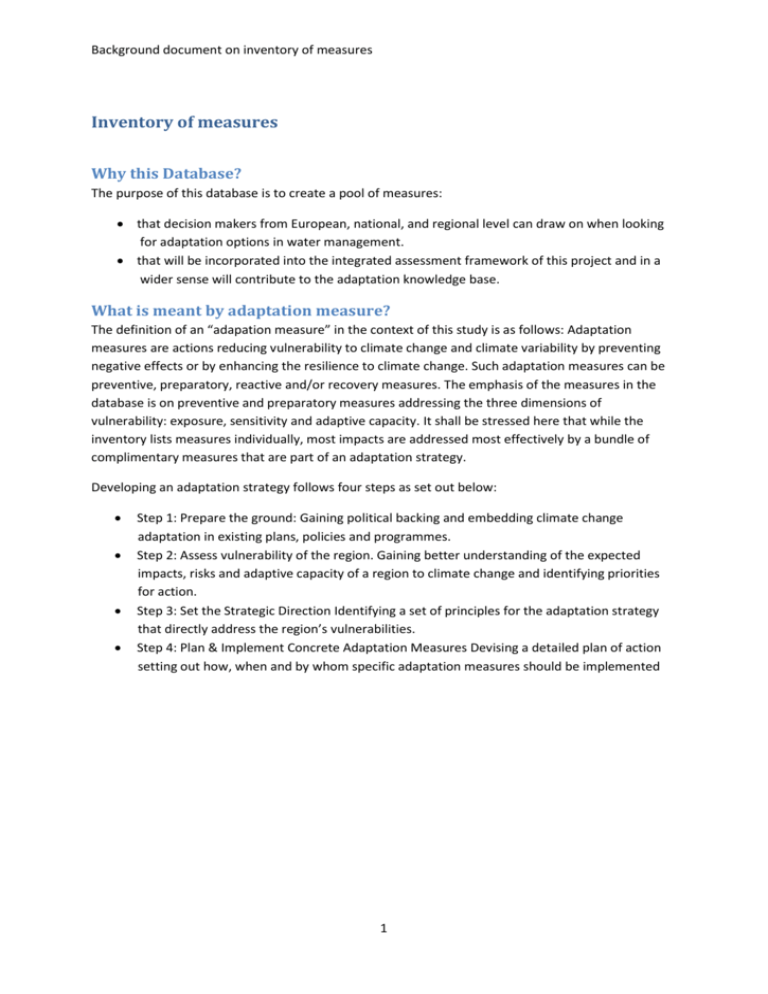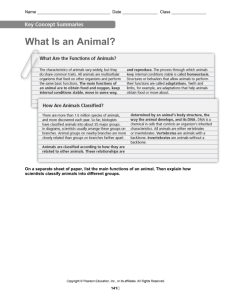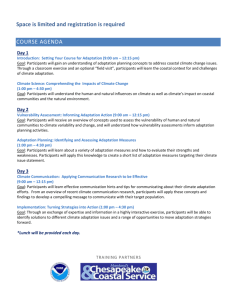Background document on inventory of measures
advertisement

Background document on inventory of measures Inventory of measures Why this Database? The purpose of this database is to create a pool of measures: that decision makers from European, national, and regional level can draw on when looking for adaptation options in water management. that will be incorporated into the integrated assessment framework of this project and in a wider sense will contribute to the adaptation knowledge base. What is meant by adaptation measure? The definition of an “adapation measure” in the context of this study is as follows: Adaptation measures are actions reducing vulnerability to climate change and climate variability by preventing negative effects or by enhancing the resilience to climate change. Such adaptation measures can be preventive, preparatory, reactive and/or recovery measures. The emphasis of the measures in the database is on preventive and preparatory measures addressing the three dimensions of vulnerability: exposure, sensitivity and adaptive capacity. It shall be stressed here that while the inventory lists measures individually, most impacts are addressed most effectively by a bundle of complimentary measures that are part of an adaptation strategy. Developing an adaptation strategy follows four steps as set out below: Step 1: Prepare the ground: Gaining political backing and embedding climate change adaptation in existing plans, policies and programmes. Step 2: Assess vulnerability of the region. Gaining better understanding of the expected impacts, risks and adaptive capacity of a region to climate change and identifying priorities for action. Step 3: Set the Strategic Direction Identifying a set of principles for the adaptation strategy that directly address the region’s vulnerabilities. Step 4: Plan & Implement Concrete Adaptation Measures Devising a detailed plan of action setting out how, when and by whom specific adaptation measures should be implemented 1 Background document on inventory of measures Prepare the ground 1. Identify adaptation measures Monitor, Gather Evaluate information & Review 4. 2. Assess vulnerabilities Engage stakeholders 3. Set strategic directions Figure 1: Steps to develop an adapation stratgy Measures in the inventory are further subdivided into nine main categories: Technical measures relate to technical infrastructure such as dykes, water supply systems, water treatment systems, roads, railways Measures related to "green" infrastructure. Green infrastructure is the interconnected network of open spaces and natural areas, that naturally accommodates stormwater, reduces flooding risk and improves water quality. Measures changing management or practices: This refers in particular to changes in farming practice or changes in water management. Risk prevention measures are measures that aim to reduce the risk of a economic damage due to non technical action. Early warning or risk maps are examples Economic and financial measures: Any economic incentive that changes the behaviour of certain people or sectors e.g. water pricing) Awareness/information measures are aiming to make human society more aware of climate change and certain adaptation needs. Land use change and allocation measures: Measures which change how land is used (e.g. reallocation of buildings, afforestation of agricultural land) Regulatory measures are measures establishing or changing laws and regulations. Long-term contingency planning measure are capturing everything with "make a plan" and "develop a strategy" Structure of the database The inventory will be compiled in the form of a database (either Excel or Access) that will be searchable and linked to additional external information where relevant. All measures are inventoried through a name and a short description and are tagged with three groups of attributes: 2 Background document on inventory of measures 1. Descriptive attributes comprise e.g. the category of measure (technical, economic & financial, etc.), the climate event that the measure is responding to (droughts, floods, etc.), or the sector it is designed for (agriculture, energy, etc.). These attributes can be used to search the database for a specific set of measures (e.g. technical measures to address water scarcity in the agricultural sector), 2. Assessment attributes are needed for the assessment exercise and include effectiveness, economic effects, side effects, flexibility, and acceptance, and 3. Addtitional information (reference, comments). Error! Reference source not found. shows the draft structure of inventory of measures. The attributes of measures are described in more detail in the Table below. The inventory will be part of the assessment framework. Moreover, we will seek to design it for further use in the foreseen Figure 2: Structure of the inventory of measures clearinghouse. What it is and what to find? The database is a matrix in a Microsoft Excel sheet that contains in the first column measures found in climate strategies and programs that are supposed to support adaptation to changes in quantity and quality of water in a certain geographical scope. The attributes of each measure are presented in the top row, for more information see section operational definitions of the different attributes. Operational definitions of the different attributes Attributes Name Description Climate events The extreme Description or operational definition Short title of the measure Explain the aim and actions will be taken Type of climate event that the measure 3 How to fill the matrix Write title Write aim and actions in detail Mark an “X” in the Background document on inventory of measures weather events that influence water quantity and quality, e.g. rising sea levels, droughts Objective of the measure Statement of the outcome to be achieved through the measure implementation is addressing. Select from: A. not enough water (measure increases availability of water and water imbalances); B. Too much water (measure reduces overflow of water from water bodies); C. Impaired water quality (measure reduces vulnerability to water quality deterioration e.g chemical, biological, and morphological); D. Snow related events (measure increase coping capacities to environmental, economic and societal impacts from changes in snow cover) Reduce exposure to droughts and water scarcity if the measure increases water supply. The exposure is the degree to which a system (e.g. company, city, farm, sector) is exposed to climatic variations of the quantity, magnitude, frequency and seasonality of available water. Reduce sensitivity to droughts and water scarcity if the measure reduces the water demand of the sector(s). Increase adaptive capacity to droughts and water scarcity if the measure increases the ability/possibility of the sector(s) to close the gap between water demand and supply. It could be achieved by increasing water supply, decreasing water demand or some combination of both. Exposure to flooding is the degree to which a system is exposed to climatic variations of the quantity, magnitude, frequency and seasonality of high waters (including sea level rise). Reduce sensitivity to flooding if the measure reduces the share of socioecological system, located in the floodprone areas. Increase adaptive capacity to floods if the measure increases the ability of a system (e.g. city, farm, company, sector, forest) to adjust to sudden high water levels moderating the potential damages, taking advantage of opportunities or coping with the consequences. Exposure to changes in water quality is 4 correct column(s) Mark an “X” in the correct column(s) Background document on inventory of measures the degree to which a system is exposed to climatic variations of the quantity, magnitude, frequency and seasonality of water quality. Reduce sensitivity to changes in water quality if the measure reduces the share of socio-ecological system, located in areas sensitive to water quality variation due intensive presence of sources of pollution and high variances in the flow level. Increase adaptive capacity to changes in water quality if the measure... Character of measure Sector affected Costs (type) To exploit benefits if the measure increases benefits through exploring new opportunities. Preventing- if the measure reduces the risk and sensitivity of people, property or nature to climate change. Preparatory- if the measure builds or enhances awareness about effects of climate change in the region (Includes carrying out studies, awareness raising and communication exchange activities). Reactive- if the measure includes the development of standards and processes to react to extreme climate events. Recovery- if the measure creates mechanisms such as establishing a funding instrument to support reconstruction or an insurance systems. Economic sub-division of society that the measure is aimed at protecting or adapting. Can be: Water management, Agriculture, Energy, Industry, Forestry, Shipping, Spatial Planning, Domestic/Tourism Investments (before the measure) Costs related to set up measure. Operational (during and maintaining measure) - Costs to run the measure Social (after) - costs of the total burden imposed by the adaptation measures, or the value lost to society including the opportunity costs of resources deployed for policy/measure implementation. Transaction costs such as pre-contract 5 Mark an “X” in the correct column(s) Mark an “X” in the correct column(s) In the respective cell, explain in detail the reason(s) for selecting this type of cost. Background document on inventory of measures Side-effects of the measure related to non adaptation issues (e.g. increase of biodiversity (Type) Time to implement Short term (5-25 years) Mid- to Longterm (25+ years) Efficiency flexibility in Easy implementation Difficult Implementation Geographic level (national, regional or river basin and municipal or company level) Reference to public participation Policy implementability (or popularity) Potential risks negotiation costs, and post-contract monitoring and enforcement costs (the latter if not included in the operational costs); Win-win – if the measure entails sidebenefits for other social, environmental or economic objectives No regrets – if the measure is be beneficial even if there is no need for adaptation, because it alleviates an existing problem Negative side effcts – if the measure negatively affects other sectors or agents For example the structural changes to river course may have as an unintended consequence a higher water stages during the flood event and thus higher probability of floods. Time until the measure becomes operational Time until the measure becomes operational ratio between the avoided costs/impacts and the costs of a measures. Perception of assessor and stakeholders about how feasible is to update/change measure in the preparatory and operational phases of the project. If this update is very feasible to make that the degree of adaptability is high – Easy, if not it is low – difficult. The territorial level that the measure is being implemented. If there is reference to public participation in the original text (program of measures or climate strategy) level of disagreement/agreement about the overall ability of the measures to deliver keeping in mind the various side-effects and/or risk augmentation Stakeholder perception of risks that may affect implementation of the measure 6 In the respective cell, explain in detail the reasons for the selection of this type of sideeffect Mark an “X” in the correct column Mark an “X” in the correct column Mark an “X” in the correct column Mark with a “yes” or a ”no” Describe major issues Describe major risks









